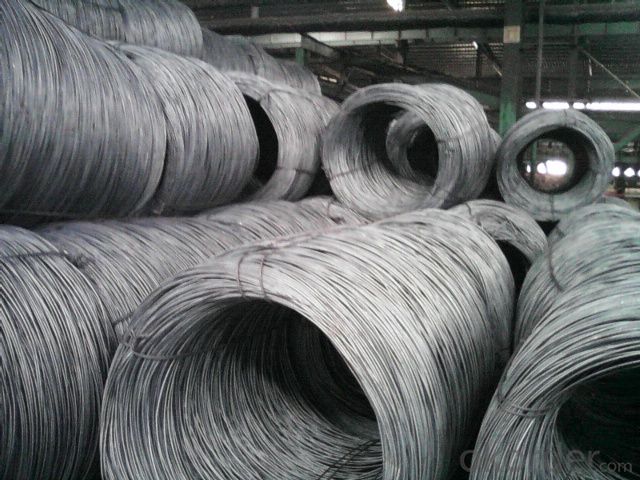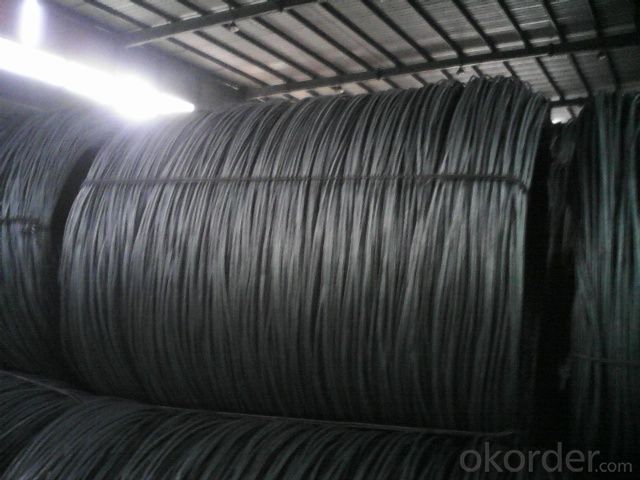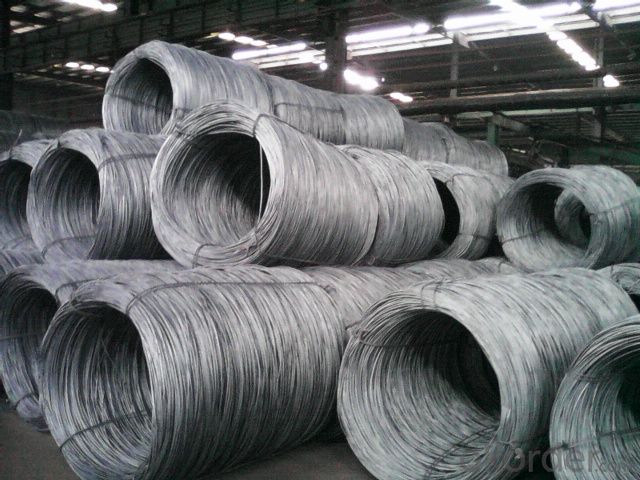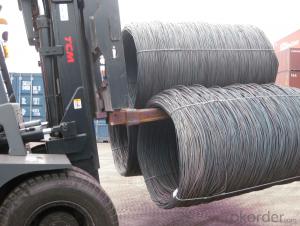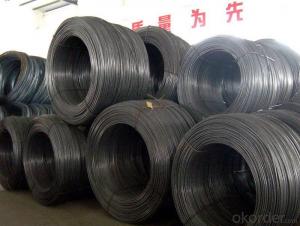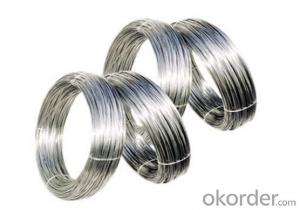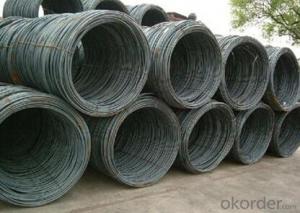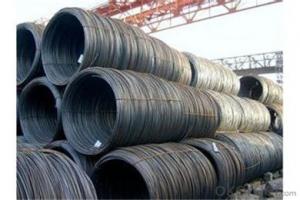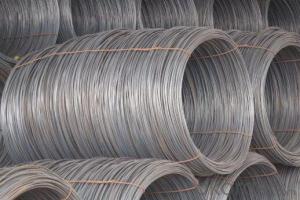5.5mm SAE1008 Low Carbon Steel Wire Rods in Coils
- Loading Port:
- Tianjin
- Payment Terms:
- TT or LC
- Min Order Qty:
- 100 m.t.
- Supply Capability:
- 40000 m.t./month
OKorder Service Pledge
OKorder Financial Service
You Might Also Like
OKorder is offering 5.5mm SAE1008 Low Carbon Steel Wire Rods in Coils at great prices with worldwide shipping. Our supplier is a world-class manufacturer of steel, with our products utilized the world over. OKorder annually supplies products to African, South American and Asian markets. We provide quotations within 24 hours of receiving an inquiry and guarantee competitive prices.
Product Applications:
5.5mm SAE1008 Low Carbon Steel Wire Rods in Coils are ideal for structural applications and are widely used for reinforcement of reinforced concrete and welded structure or reprocessed (roberts , nail, etc.) materials, especially used to produce wire drawing, welding electrode, nails, spring, electronic, precise machinery parts and so on..
Product Advantages:
OKorder's 5.5mm SAE1008 Low Carbon Steel Wire Rods in Coils are durable, strong, and wide variety of sizes.
Main Product Features:
· Premium quality
· Prompt delivery & seaworthy packing (30 days after receiving deposit)
· Can be recycled and reused
· Mill test certification
· Professional Service
· Competitive pricing
Product Specifications:
Manufacture: Hot rolled
Grade: SAE1008
Certificates: ISO, SGS, BV, CIQ
Packed: prproduct packed in coils, usually shipped by bulk vessel
Coil weight: about 2mts/ coil
Grade | Chemical Composition(%) | |||||
C | Mn | Si | S | P | B | |
SAE1008B | 0.10max | 0.3~O.50 | 0.15max | 0.050max | 0.040 max | 0.0008 min |
Mechanical properties | ||||||
Yield strength(N/mm2) | Tensile strength(N/mm2) | Elongation(%) | ||||
≥195 | 315-430 | ≥30 | ||||
Grade | Chemical Composition(%) | |||||
C | Mn | Si | S | P | B | |
Q195B | 0.06~O.12 | 0.25~O.50 | ≤0.30 | ≤0.050 | ≤0.045 | >0.0008 |
Mechanical properties | ||||||
Yield strength(N/mm2) | Tensile strength(N/mm2) | Elongation(%) | ||||
≥195 | 315-430 | ≥33 | ||||
FAQ:
Q1: Why buy Materials & Equipment from OKorder.com?
A1: All products offered byOKorder.com are carefully selected from China's most reliable manufacturing enterprises. Through its ISO certifications, OKorder.com adheres to the highest standards and a commitment to supply chain safety and customer satisfaction.
Q2: How do we guarantee the quality of our products?
A2: We have established an advanced quality management system which conducts strict quality tests at every step, from raw materials to the final product. At the same time, we provide extensive follow-up service assurances as required.
Q3: How soon can we receive the product after purchase?
A3: Within three days of placing an order, we will arrange production. The normal sizes with the normal grade can be produced within one month. The specific shipping date is dependent upon international and government factors, the delivery to international main port about 45-60days.
Q4: How many tons of steel products could be loaded in containers?
A4: Usually the steel products are delivered by bulk vessel because of the large quantity and the freight. However, there are no bulk vessel enter some seaports so that we have to deliver the cargo by containers. The 6m steel product can be loaded in 20FT container, but the quantity is changed according to the size, usually from 18tons to 25tons.
Images:
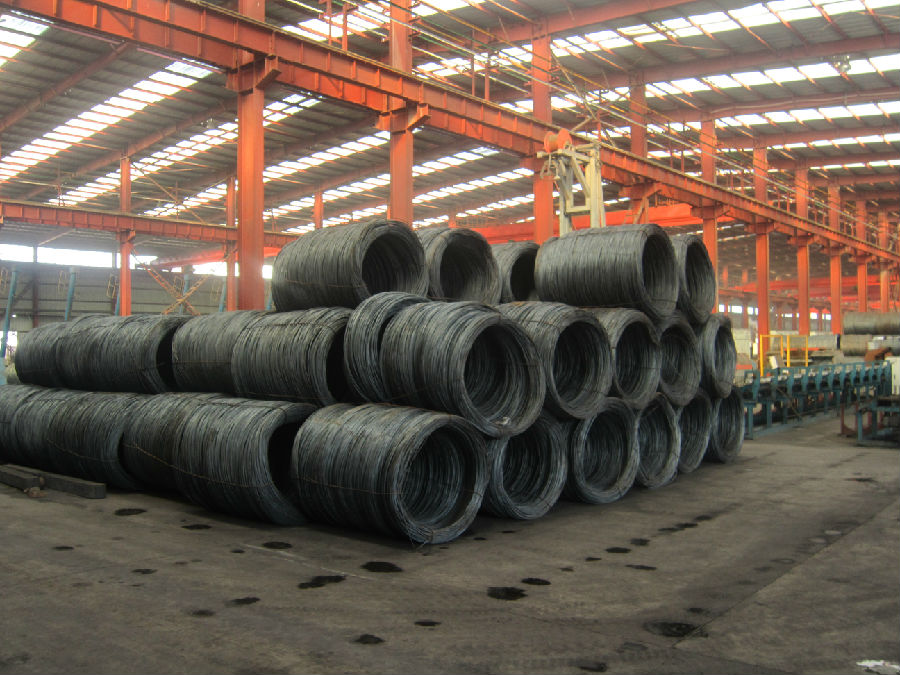
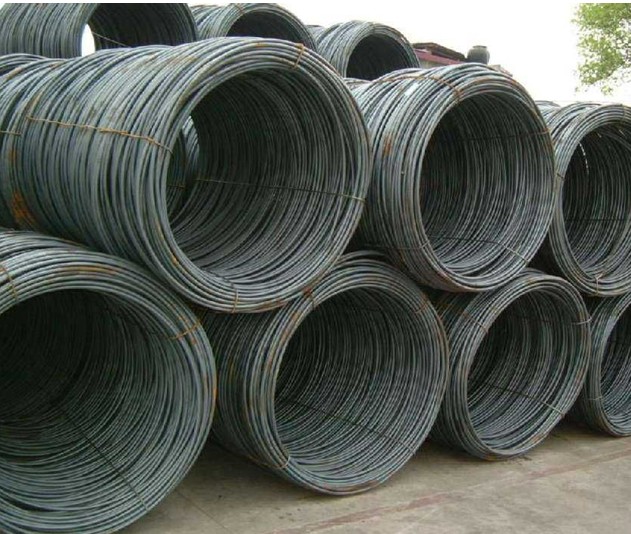
- Q: How is the weldability of steel wire rod evaluated?
- The weldability of steel wire rod is evaluated using various techniques and criteria. One of the key factors in assessing weldability is the chemical composition of the steel wire rod. The presence of certain elements, such as carbon, sulfur, and phosphorus, can significantly impact the weldability of the material. Additionally, the mechanical properties of the steel wire rod, such as its tensile strength, ductility, and toughness, are important considerations. These properties can affect the quality and integrity of the weld joint. Another factor to evaluate weldability is the surface condition of the steel wire rod. Any contaminants or impurities on the surface can negatively affect the weldability and lead to defects in the weld. Furthermore, the welding process and parameters used play a crucial role in determining the weldability of steel wire rod. Factors such as heat input, welding speed, and shielding gas selection need to be optimized to ensure proper fusion and minimize the risk of defects. To evaluate the weldability, various tests and inspections are conducted. These include visual examination of the weld for defects like cracks, porosity, or lack of fusion. Non-destructive testing methods like ultrasonic testing or radiography can be used to detect any internal flaws or inconsistencies. Additionally, mechanical tests like tensile and bend testing are performed to evaluate the strength and ductility of the weld joint. These tests help assess the overall quality and performance of the welded steel wire rod. In summary, the weldability of steel wire rod is evaluated by considering factors such as chemical composition, mechanical properties, surface condition, welding process, and conducting tests and inspections to ensure the quality and integrity of the weld joint.
- Q: What are the transportation options for steel wire rod?
- The transportation options for steel wire rods include trucking, rail, and shipping.
- Q: What are the main factors affecting the quality of steel wire rod?
- There are several main factors that affect the quality of steel wire rod. Firstly, the chemical composition of the steel plays a crucial role. The presence of impurities, such as sulfur and phosphorus, can significantly impact the strength, ductility, and overall quality of the wire rod. Therefore, strict control over the chemical composition is essential to ensure high-quality steel wire rod. Secondly, the manufacturing process and the quality of raw materials used are important factors. The steelmaking process, including melting, refining, and casting, must be carefully controlled to avoid any contamination or defects that could weaken the wire rod. The quality of the raw materials, such as iron ore and scrap metal, also affects the final product. Using high-quality raw materials can result in enhanced mechanical properties and overall quality of the wire rod. Thirdly, the heat treatment process is crucial in determining the quality of steel wire rod. Proper heat treatment, which involves controlled heating and cooling processes, can significantly improve the mechanical properties of the wire rod, such as tensile strength and hardness. It also helps in reducing internal stresses and improving the microstructure of the steel, thereby enhancing its overall quality. Another important factor is the surface quality of the wire rod. Any surface defects, such as cracks, scale, or unevenness, can adversely affect the wire rod's performance in various applications. Therefore, proper surface preparation and inspection are necessary to ensure a smooth and defect-free surface. Furthermore, the mechanical and physical properties of the steel wire rod, such as tensile strength, ductility, and toughness, greatly impact its quality. These properties are influenced by various factors, including the steel's microstructure, grain size, and the presence of any residual stresses. It is important to control and optimize these factors during the manufacturing process to achieve the desired mechanical and physical properties. Lastly, adherence to stringent quality control measures throughout the entire production process is crucial in ensuring the quality of steel wire rod. Regular testing and inspection of the raw materials, intermediate products, and final wire rod are essential to detect any deviations or defects and take corrective actions promptly. In conclusion, the main factors affecting the quality of steel wire rod include the chemical composition, manufacturing process, heat treatment, surface quality, mechanical and physical properties, and adherence to quality control measures. By carefully controlling and optimizing these factors, manufacturers can produce high-quality steel wire rod that meets the desired specifications and performance requirements.
- Q: What are the environmental benefits of recycling steel wire rod?
- There are several environmental benefits of recycling steel wire rod. Firstly, recycling steel wire rod helps conserve natural resources by reducing the need for mining and extracting raw materials. This reduces the environmental impact associated with mining activities, such as deforestation and habitat destruction. Secondly, recycling steel wire rod reduces energy consumption and greenhouse gas emissions. Producing steel from recycled materials requires significantly less energy compared to producing steel from virgin ore. This helps mitigate climate change by reducing carbon dioxide emissions and other pollutants associated with steel production. Additionally, recycling steel wire rod helps in reducing waste in landfills. By diverting steel wire rod from disposal sites, valuable landfill space is conserved, and the potential for soil and water contamination from landfill leachate is minimized. Overall, recycling steel wire rod contributes to a more sustainable and environmentally friendly approach to steel production, conserving resources, reducing energy consumption, and minimizing waste.
- Q: How is steel wire rod used in the manufacturing of wire forms for automotive cooling systems?
- Steel wire rod is commonly used in the manufacturing of wire forms for automotive cooling systems due to its excellent strength and durability properties. Wire forms are essential components in these systems as they provide structural support and help maintain the desired shape and functionality of various cooling system components. One of the main applications of steel wire rod in automotive cooling systems is in the production of radiator cores. Radiator cores are typically made up of a network of small tubes and fins that are responsible for transferring heat from the engine coolant to the surrounding air. These tubes and fins are often connected and supported by wire forms made from steel wire rod. Steel wire rod is selected for this purpose due to its high tensile strength, which allows the wire forms to withstand the pressure and vibration that occur in automotive cooling systems. Additionally, steel wire rod offers excellent resistance to corrosion, ensuring the longevity and reliability of the wire forms in harsh operating conditions. In the manufacturing process, steel wire rod is first formed into the desired shape using specialized machinery. The wire is then subjected to various heat treatment processes to enhance its strength and flexibility. Once the wire forms are fabricated, they are integrated into the radiator core assembly, providing support and stability to the tubes and fins. Moreover, steel wire rod is also used in the manufacturing of other wire forms in automotive cooling systems, such as hose clamps, brackets, and hooks. These wire forms play crucial roles in securing hoses, connecting components, and providing structural support to ensure the proper functioning of the cooling system. Overall, steel wire rod is an essential material in the manufacturing of wire forms for automotive cooling systems. Its strength, durability, and corrosion resistance make it an ideal choice for supporting and maintaining the integrity of various cooling system components, ultimately contributing to the efficient operation of the automotive cooling system.
- Q: What are the advantages of using galvanized steel wire rod?
- There are several advantages of using galvanized steel wire rod. Firstly, galvanized steel wire rod has a high level of corrosion resistance. This is due to the zinc coating that is applied to the surface of the wire rod. The zinc acts as a protective barrier, preventing rust and corrosion from forming on the steel. This makes galvanized steel wire rod suitable for outdoor applications, where it may be exposed to moisture and harsh weather conditions. Secondly, galvanized steel wire rod is incredibly durable. The zinc coating adds an extra layer of protection to the steel, making it more resistant to wear and tear. This means that galvanized steel wire rod can withstand heavy loads and is less likely to break or deform under stress. This durability makes it ideal for use in construction, fencing, and other demanding applications. Another advantage of galvanized steel wire rod is its versatility. It can be easily bent, twisted, and cut to suit various applications. This makes it a popular choice for a wide range of industries, including agriculture, automotive, and manufacturing. Galvanized steel wire rod can be used for making fences, wire mesh, springs, and various other products. Additionally, galvanized steel wire rod is cost-effective. While the initial cost of galvanizing the wire rod may be higher compared to other types of steel, the long-term benefits outweigh the upfront investment. The corrosion resistance and durability of galvanized steel wire rod mean that it requires less maintenance and has a longer lifespan, reducing the need for frequent replacements. Lastly, galvanized steel wire rod is environmentally friendly. The zinc coating used in the galvanizing process is non-toxic and recyclable. This means that galvanized steel wire rod can be easily recycled at the end of its lifespan, reducing waste and minimizing its impact on the environment. In conclusion, the advantages of using galvanized steel wire rod include high corrosion resistance, durability, versatility, cost-effectiveness, and environmental friendliness. These qualities make it a preferred choice for various applications in different industries.
- Q: How is steel wire rod used in the manufacturing of wire baskets for industrial applications?
- Steel wire rod is an essential raw material used in the manufacturing of wire baskets for industrial applications. The wire rod serves as the base material from which the wire baskets are formed. To begin the manufacturing process, the steel wire rod is first carefully selected and inspected for its quality and specifications. It is important for the wire rod to have the desired strength, flexibility, and durability required for industrial applications. Once the wire rod meets the necessary standards, it is then subjected to various processes to transform it into wire baskets. The first step in the manufacturing process involves drawing the steel wire rod through a series of dies to reduce its diameter and increase its length. This process is known as wire drawing. The wire drawing process helps in improving the wire rod's surface finish, strength, and dimensional accuracy. After wire drawing, the steel wire rod is then further processed through various techniques such as annealing, cleaning, and coating. Annealing helps to relieve any internal stresses in the wire and enhance its ductility, making it easier to form into wire baskets. Cleaning removes any impurities or contaminants from the wire rod's surface, ensuring a clean and smooth finish. Coating involves applying a protective layer on the wire rod to prevent corrosion and enhance its durability. Once the wire rod is prepared, it is ready to be formed into wire baskets. The wire rod is fed into a machine called a wire basket forming machine, where it is bent, twisted, and shaped into the desired basket design. The machine uses various mechanisms, such as rollers and dies, to mold the wire rod into the required shape and size. After the wire rod has been formed into wire baskets, they undergo further processes such as welding, cutting, and finishing. Welding is used to join the different sections of the wire basket together, ensuring its structural integrity. Cutting is performed to trim any excess wire and achieve the desired dimensions. Finally, the wire baskets are finished by removing any sharp edges, polishing the surface, and applying any required surface treatment or coating. In summary, steel wire rod plays a crucial role in the manufacturing of wire baskets for industrial applications. It serves as the primary material from which the wire baskets are formed, and its properties are vital in determining the strength, durability, and overall quality of the final product. Through a series of processes, the wire rod is transformed into wire baskets, which are then used in various industrial applications such as storage, transportation, and organization of goods.
- Q: How does the ductility of steel wire rod vary with different heat treatment processes?
- The ductility of steel wire rod can vary with different heat treatment processes. Heat treatment processes such as annealing and tempering can improve the ductility of steel wire rod by reducing its hardness and increasing its flexibility. On the other hand, processes like quenching and martempering can decrease the ductility of steel wire rod by increasing its hardness and brittleness. Therefore, the specific heat treatment process chosen can significantly affect the ductility of steel wire rod.
- Q: What are the different mechanical tests conducted on steel wire rod?
- Some of the different mechanical tests conducted on steel wire rod include tensile strength testing, hardness testing, impact testing, and bend testing. These tests help determine the strength, durability, and flexibility of the steel wire rod, ensuring it meets the required specifications and standards for various applications.
- Q: What are the different types of steel wire rod coatings available?
- There are several different types of coatings available for steel wire rods, each providing distinct properties and advantages. Some of the most common types of coatings include: 1. Galvanized Coating: This coating involves the application of a layer of zinc onto the surface of the steel wire rod. Galvanizing provides excellent corrosion resistance, making it suitable for outdoor applications and environments with high humidity or exposure to corrosive substances. 2. Phosphating Coating: Phosphating is a chemical conversion process that creates a thin layer of phosphate crystals on the surface of the steel wire rod. This coating enhances the adhesion of subsequent coatings, improves corrosion resistance, and provides a good base for painting or further treatment. 3. Polymer Coating: Polymer coatings, such as polyethylene or polypropylene, are often applied to steel wire rods to provide protection against corrosion, abrasion, and chemical exposure. These coatings offer excellent flexibility and can be customized to meet specific requirements, such as UV resistance or electrical insulation. 4. Epoxy Coating: Epoxy coatings are known for their exceptional adhesion and chemical resistance. They are commonly used in applications where the steel wire rod will be exposed to harsh chemicals, such as in the oil and gas industry or in marine environments. Epoxy coatings can also provide protection against corrosion and abrasion. 5. Zinc-Aluminum Coating: This coating, also known as Galvalume or Zincalume, involves the application of a layer of zinc-aluminum alloy onto the steel wire rod. Zinc-aluminum coatings provide excellent corrosion resistance and are often used in applications where both corrosion protection and heat resistance are required, such as in automotive or construction industries. 6. Copper Coating: Copper coatings are primarily used for their electrical conductivity properties. They are often applied to steel wire rods that will be used in electrical applications, such as wiring or cables, to enhance conductivity and reduce electrical resistance. These are just a few examples of the different types of coatings available for steel wire rods. The choice of coating depends on the specific application requirements, such as corrosion resistance, electrical conductivity, or chemical resistance, and it is essential to select the appropriate coating to ensure optimal performance and durability of the steel wire rods.
Send your message to us
5.5mm SAE1008 Low Carbon Steel Wire Rods in Coils
- Loading Port:
- Tianjin
- Payment Terms:
- TT or LC
- Min Order Qty:
- 100 m.t.
- Supply Capability:
- 40000 m.t./month
OKorder Service Pledge
OKorder Financial Service
Similar products
Hot products
Hot Searches
Related keywords



